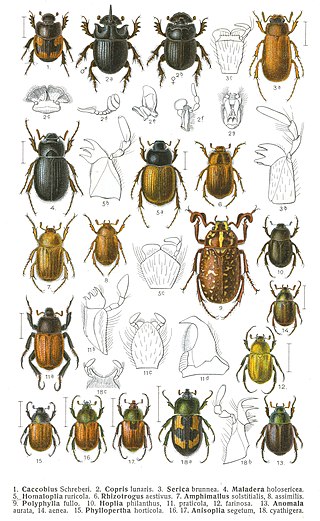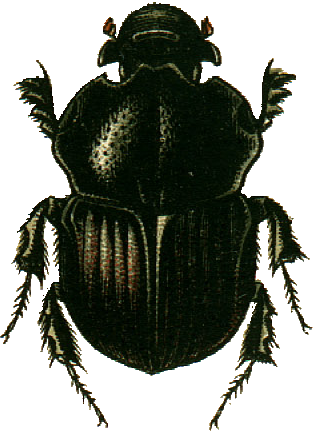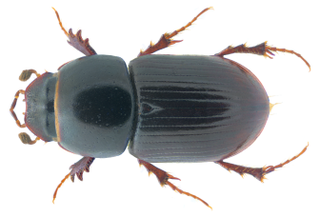
Beetles are insects that form the order Coleoptera, in the superorder Holometabola. Their front pair of wings are hardened into wing-cases, elytra, distinguishing them from most other insects. The Coleoptera, with about 400,000 described species, is the largest of all orders, constituting almost 40% of described insects and 25% of all known animal species; new species are discovered frequently, with estimates suggesting that there are between 0.9 and 2.1 million total species. However, the number of beetle species is challenged by the number of species in dipterans (flies) and hymenopterans (wasps).

The family Scarabaeidae, as currently defined, consists of over 35,000 species of beetles worldwide; they are often called scarabs or scarab beetles. The classification of this family has undergone significant change. Several groups formerly treated as subfamilies have been elevated to family rank, and some reduced to lower ranks. The subfamilies listed in this article are in accordance with those in Catalog of Life (2023).

Dung beetles are beetles that feed on feces. Some species of dung beetles can bury dung 250 times their own mass in one night.

Scarabaeoidea is a superfamily of beetles, the only subgroup of the infraorder Scarabaeiformia. Around 35,000 species are placed in this superfamily and some 200 new species are described each year. Its constituent families are also undergoing revision presently, and the family list below is only preliminary. This superfamily includes some of the largest beetles extant today, including rhinoceros beetles, (Dynastinae), the Hercules beetle and Goliath beetles.

The scarab beetle subfamily Scarabaeinae consists of species collectively called true dung beetles. Most of the beetles of this subfamily feed exclusively on dung. However, some may feed on decomposing matter including carrion, decaying fruits and fungi. Dung beetles can be placed into three structural guilds based on their method of dung processing namely rollers (telecoprids), dwellers (endocoprids) and tunnelers (paracoprids). Dung removal and burial by dung beetles result in ecological benefits such as soil aeration and fertilization; improved nutrient cycling and uptake by plants, increase in Pasture quality, biological control of pest flies and intestinal parasites and secondary seed dispersal. Well-known members include the genera Scarabaeus and Sisyphus, and Phanaeus vindex.

Scarabaeus sacer, common name sacred scarab, is the type species of the genus Scarabaeus and the family Scarabaeidae. This dung beetle is native of southern Europe, northern Africa and western Asia, and it was venerated in ancient Egypt.

Digitonthophagus gazella is a species of scarab beetle. It belongs to the genus Digitonthophagus, which was promoted from subgenus to genus level in 1959. There has been some confusion regarding the application of the names with many people using the outdated name Onthophagus gazella. Dung beetle experts use the term Digitonthophagus gazella.

Bubas bubalus is a species of beetle of the subfamily Scarabaeinae within the family Scarabaeidae. It is widespread in central and northern Spain, southern France, Portugal, Gibraltar, Monaco and Italy. The species could also be found on the Balearic Islands. They like a temperate climate. Adults are found in manure from October to July.

Teuchestes fossor is a species of dung beetle native to the Palaearctic, but is also widespread in North America following accidental introduction and naturalisation during European settlement. Both adults and larvae are coprophagous, differentiating resource use by respectively feeding on the liquid and fibrous fractions of herbivore dung. It can be readily collected from the dung of livestock, and other large mammals This species is known to support a number of key ecosystem services in cattle pastures.

Agrilinus ater is a species of beetle in family Scarabaeidae, found in the Palearctic. It is a mid-successional species of sheep and cattle dung

Cartwrightia is a genus of scarab found in Latin America. It was named and circumscribed in 1958 by Federico Islas Salas. As of 2017, three species are recognized: C. intertribalis, C. cartwrighti, and C. islasi. They can be found in the nests of leafcutter ants or in dung.
Onthophagus unifasciatus, is a species of true dung beetle native to India and Sri Lanka.

Aganocrossus urostigma, is a species of dung beetle found with a widespread distribution from Southern Afghanistan, Pakistan, India, Sri Lanka, Nepal, Bhutan, China; Taiwan, Korean Peninsula, Japan, towards Vietnam, Laos, Cambodia, Thailand, Malaysia: Malacca and Borneo; Indonesia, Philippines, and Russia.

Calamosternus granarius is a species of dung beetle found with a widespread distribution.

Copris repertus, is a species of dung beetle found in India, Sri Lanka and Myanmar.
Delopleurus parvus, is a species of dung beetle found in India, Sri Lanka and Nepal.

Digitonthophagus bonasus, is a species of dung beetle found in India, Sri Lanka, Pakistan, Nepal, Myanmar, Thailand, Afghanistan, Vietnam and Cambodia.
Onitis crenatus, is a species of dung beetle found in Afro-Asian countries.
Onthophagus falsus, is a species of dung beetle found in India, Sri Lanka and Pakistan.

Phaeochrous emarginatus, is a species of scavenger scarab beetle found in India, Sri Lanka, Bhutan, China, Taiwan, Japan, Laos, Myanmar, Thailand, Malaysia, Vietnam, Indonesia, Philippines, New Guinea, Ryukyu Archipelago, and Australia.
















